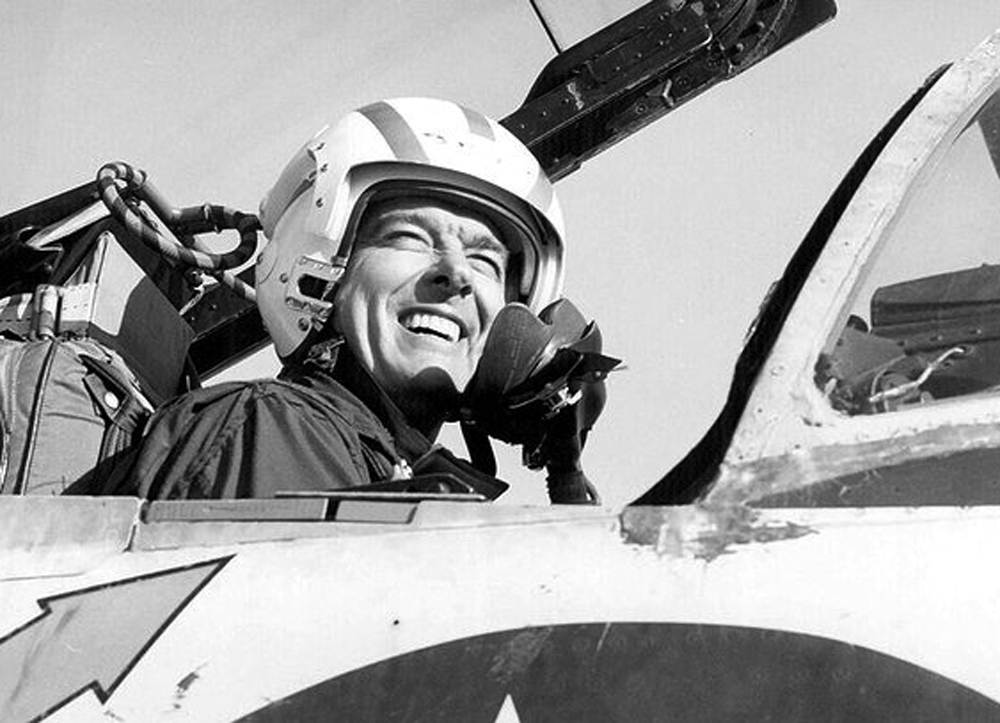

Lieutenant Commander Watkins wore a David Clark Co. C-1 capstan-type partial-pressure suit with an International Latex Corporation (ILC Dover) K-1 helmet and face plate for protection at high altitudes.
The Valley Times reported:
Edwards Flier Sets Altitude Mark For Jets
By WALT KEESHAN JR.
Valley Times Aviation Editor
EL CENTRO — The world’s altitude record for jet planes has been taken to the Antelope Valley by a Navy pilot dressed in a Mars-like suit who flew to the edge of space at 76,828.8 feet above Mojave.
This historic event, announced yesterday at the third annual Naval Air Weapons meet, staged in the Imperial Valley, brought the Distinguished Flying Cross to LCDR George C. Watkins, 37, who gave America the first altitude record it has held in 28 years. The flight was Wednesday.
Flying a F-11-1F Super Tiger, Watkins, of Pasadena, proved that jet airplanes can operate for a brief period of time 14 miles above earth—a period long enough to launch missiles into space.
45-Minute Flight
The actual flight which took Watkins up into the Ozonosphere lasted 45 minutes and covered a distance of 500 miles stretching from Needles to Mojave. He stayed at the record altitude for four seconds.
Watkins flew in a patch like a ballistic missile strapped in his swept-wing fighter, Outside the snug cockpit the temperature was 69 degrees below zero.
The swept-wing fighter shot from the Edwards Air Force Base runway loaded with 6,270 pounds of fuel and raced for Needles, 210 miles to the east.
Making a U-turn 30 miles beyond Needles, Watkins poured on teh speed and dashed toward Edwards with his throttle wide open at 1,260 miles per hour (Mach 1.9) at 40,000 feet.
Cruise Climb
Watkins slowly began to cruise climb, rising 1,500 feet a minute until he had only 400 pounds of fuel left. Rising skyward the afterburner cut off at 65,000 feet and he was on his way.
The altimeter began to spin crazily and all the energy he had built up pushed him up at a rate of 50,000 feet a minute in what pilots call a zoom-glide.
As he eased over the top at 76,828.8 feet, the Super Tiger was only going 100 miles an hour and Watkins was experiencing zero-gravity for more than a minute—an uncomfortable 60 seconds when he became weightless and objects began floating in the cockpit.
Outside the sky was very deep blue. He was the first jet pilot to see this new color. “I hardly had time to look,” Watkins said.
Lands Without Fuel
During the record run he had to hit a five mile square area in the sky so that radar cameras on the ground could officially record his record. He landed without enough fuel to taxi back to the hangar.
The record run was part of “Operation Apollo” now being staged at Edwards. He will try for 84,000 feet probably the first part of next week when the temperature gets down to a minus 79 degrees outside. The colder it is the faster he can go.
The Air Force and the Navy are both interested in this altitude mark because solid missiles could be launched from these sky platforms and fired at tremendously increased distances—maybe put in orbit.
The record Watkins broke was 70,308 feet set by the British last year in a combination jet and rocket powered airplane.
—Valley Times, Vol. 21, No. 93, Friday 18 April 1958, Page 1, Column 3, and Page 2, Column 3
Watkins’ flight was observed by the National Aeronautic Association and certified by the Fédération Aéronautique Internationale (FAI). For his record-setting flight, Lieutenant Commander Watkins was presented the Distinguished Flying Cross by Vice Admiral William F. Davis, Jr., Deputy Chief of Operations for Air.
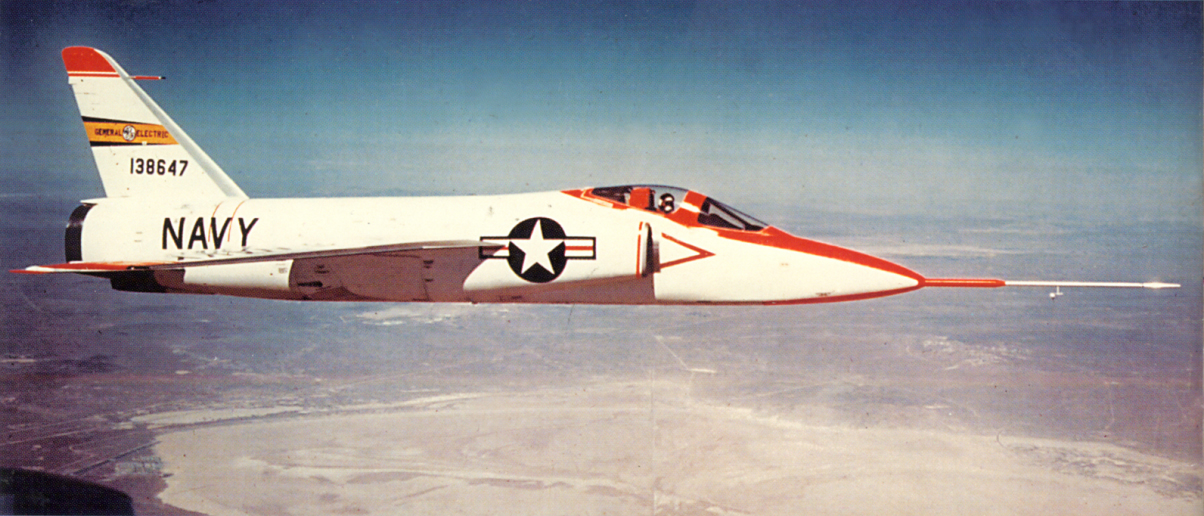
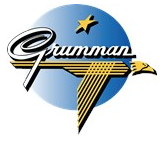
The U.S. Navy determined that the F11F-2 was too heavy for operation aboard carriers and did not place any orders. The designation was changed from F11F-2 to F11F-1F, and later, to F-11B, although the remaining aircraft was no longer flying by that time.
The F11F-1F Tiger is 48 feet, 0.5 inches (14.643 meters) long with a wingspan of 31 feet, 7.5 inches (9.639 meters) and overall height of 13 feet, 10 inches (4.216 meters). The Super Tiger has an empty weight of 16,457 pounds (7,465 kilograms) and maximum takeoff weight of 26,086 pounds (11,832 kilograms).

With the YJ79 engine, the F11F-1F has a maximum speed of 836 miles per hour (1,345 kilometers per hour) at Sea Level, 1,325 miles per hour (2,132 kilometers per hour) at 35,000 feet (10,668 meters) and 1,400 miles per hour (2,253 kilometers per hour) at 40,000 feet (12,192 meters). Cruise speed is 580 miles per hour (933 kilometers per hour). It had an initial rate of climb of 8,950 feet per minute (45.5 meters per second) and service ceiling of 50,300 feet (15,331 meters). Range with internal fuel was 1,136 miles (1,828 kilometers).
The Tiger’s armament consisted of four 20 mm Colt Mk 12 autocannon with 125 rounds of ammunition per gun, and four AIM-9 Sidewinder heat-seeking missiles.
The single remaining F11F-1F, Bu. No. 138647, is on static display at the Naval Air Weapons center, China Lake, California.
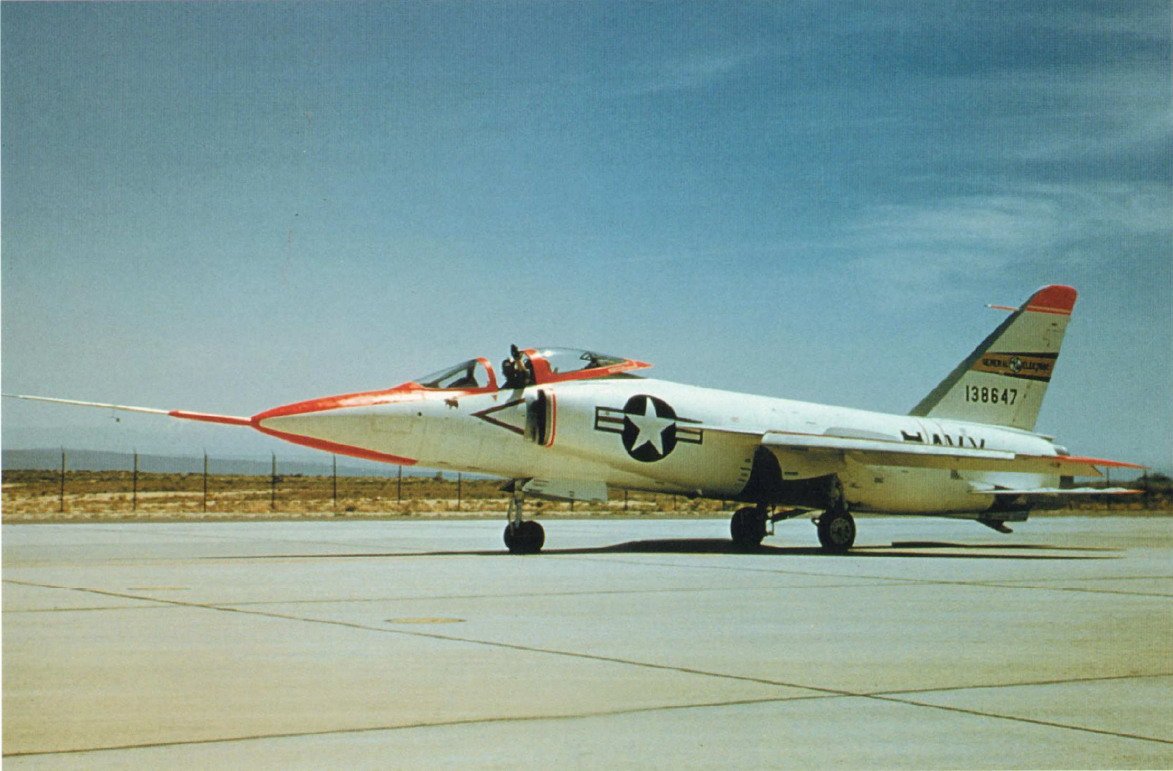
George Clinton Watkins was born at Alhambra, California, 10 March 1921, the third of seven children of Edward Francis Watkins, a purchasing agent for the Edison Company, and Louise Whipple Ward Watkins. (Mrs. Watkins was a candidate for election to the United States Senate in 1938.) George’s brother, James, would later serve as Chief of Naval Operations.
George was educated at the Army and Navy Academy, Carlsbad, California, and at The Citadel, the Military College of South Carolina, before being appointed to the United States Naval Academy, Annapolis, Maryland. He entered the Academy 3 July 1940. He graduated and was commissioned as an Ensign, United States Navy, 9 June 1943. He was then assigned as a gunnery officer aboard the battleship, USS Pennsylvania (BB-38). Ensign Watkins was promoted to the rank of lieutenant (junior grade), 1 September 1944.
Near the end of the war, Lieutenant (j.g.) Watkins entered pilot training. He graduated and was awarded the gold wings of a Naval Aviator in 1945. He was promoted to the rank of lieutenant, 1 April 1946. His first operational assignment was as pilot of a Grumman TBF Avenger torpedo bomber with VT-41. In 1950 Watkins attended the Navy’s test pilot school at NAS Patuxent River on the Chesapeake Bay, Maryland. Among his classmates were future astronauts John H. Glenn and Alan B. Shepard. Lieutenant Watkins served as a fighter pilot during the Korean War, flying the Grumman F9F-6 with VF-24, aboard USS Yorktown (CVA-10)then returned to duty as a test pilot. On 1 January 1954, he was promoted to lieutenant commander.
George Watkins was the first U.S. Navy pilot to fly higher than 60,000 feet (18,288 meters), and 70,000 feet (21,336 meters). In 1956, he set a speed record of 1,210 miles per hour (1,947.3 kilometers per hour). Lieutenant Commander Watkins was promoted to the rank of commander, 1 March 1958. He was assigned as Commander Air Group 13 in August 1961. On 9 May 1962, Commander Watkins became the first U.S. Navy pilot to have made 1,000 aircraft carrier landings.
Commander Watkins was promoted to the rank of captain, 1 July 1964. Captain Watkins served in planning assignments at the Pentagon, and was an aide to Presidents Kennedy, Johnson and Nixon.
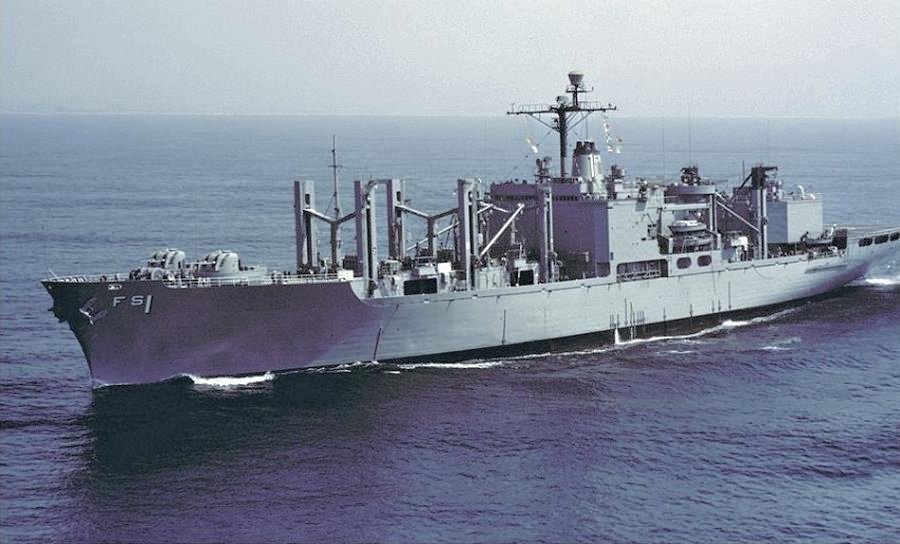
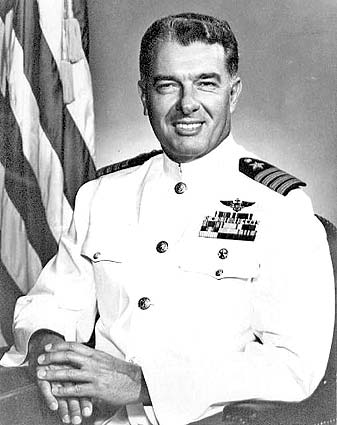
From 14 December 1965 to 12 December 1966, Captain Watkins commanded USS Mars (AFS-1), a combat stores ship. (Experience commanding a deep draft ship was a requirement before serving as captain of an aircraft carrier).
He later served as a technical adviser for the 1970 20th Century Fox/Toei Company movie, “Tora! Tora! Tora!,” about the Japanese attack against Pearl Harbor which brought the United States of America into World War II.
By the time Captain Watkins retired from the Navy in 1973, he had flown more than 200 aircraft types, made 1,418 landings on 37 aircraft carriers, and logged more than 16,000 flight hours. He continued flying after he retired, operating sailplane schools at Santa Monica and Lompoc, California. He had flown more than 21,000 hours during 26,000 flights.
Captain Watkins married Miss Monica Agnes Dobbyn, 20 years his junior, at Virginia Beach, Virginia, 9 June 1979. Mrs. Watkins is the author of Cats Have Angels Too, Angelaura & Company, 1998.
Captain Watkins died 18 September 2005 at the age of 84 years. His ashes were spread at sea from the deck of a United States Navy aircraft carrier.
¹ FAI Record File Number 8596
© 2019, Bryan R. Swopes